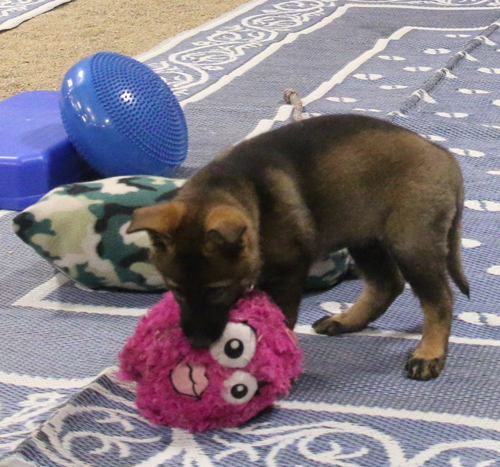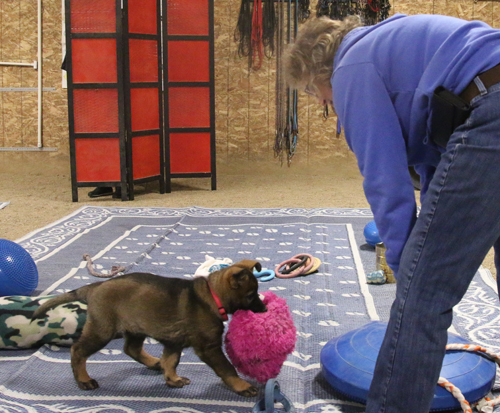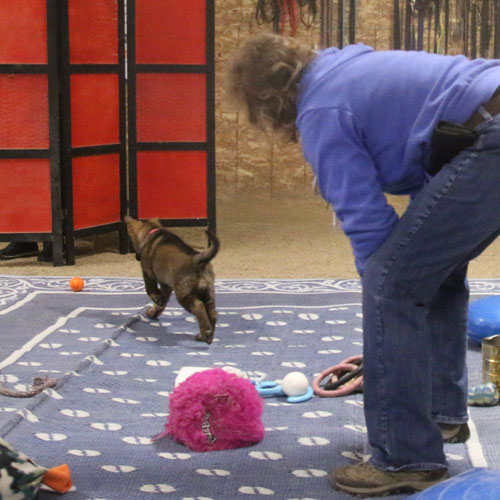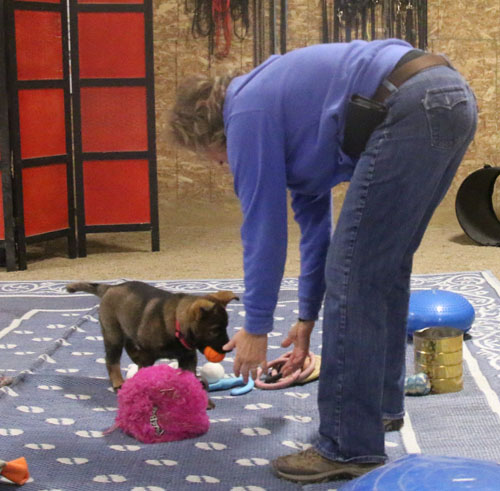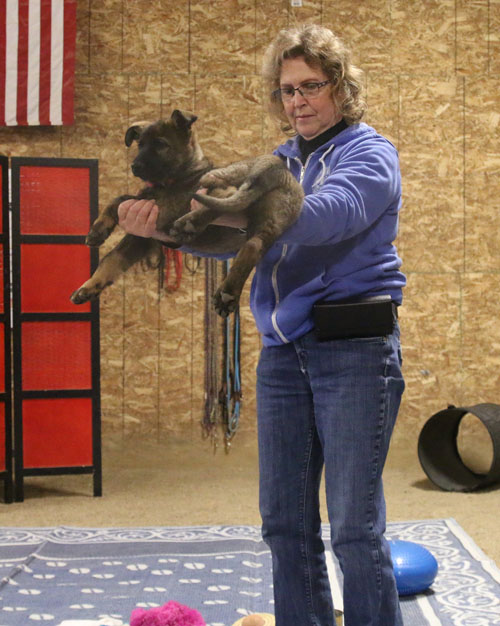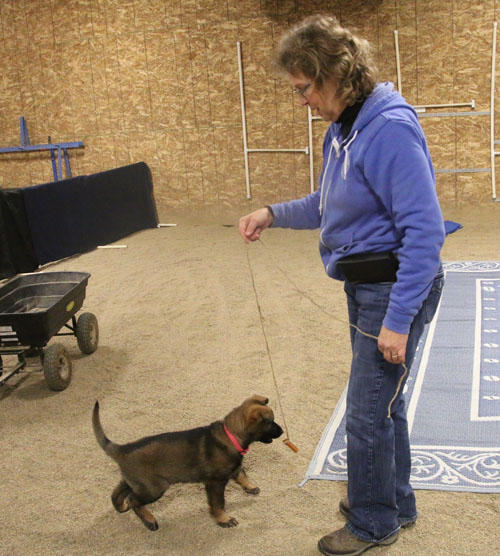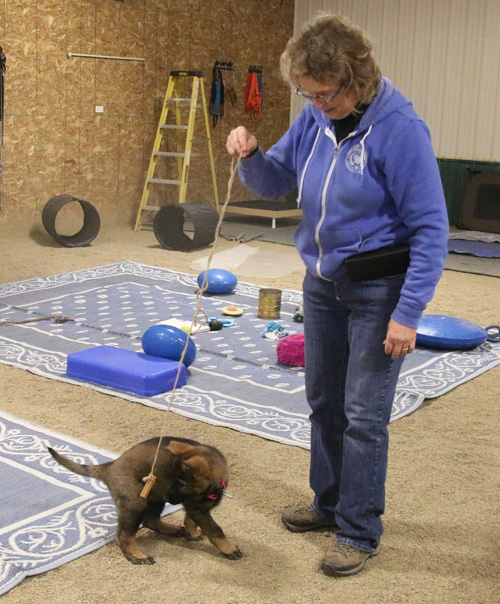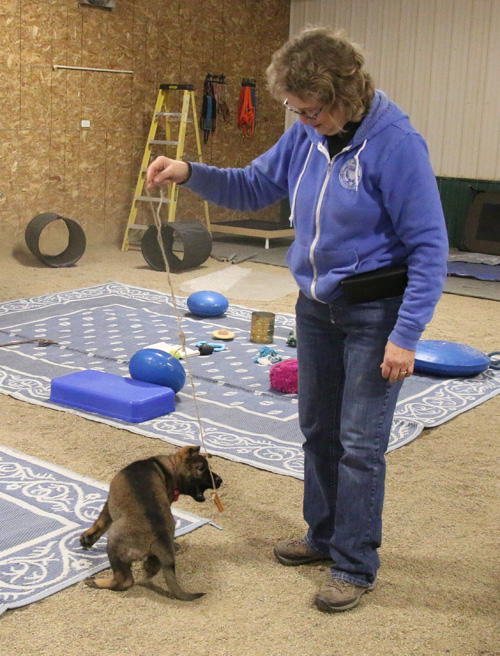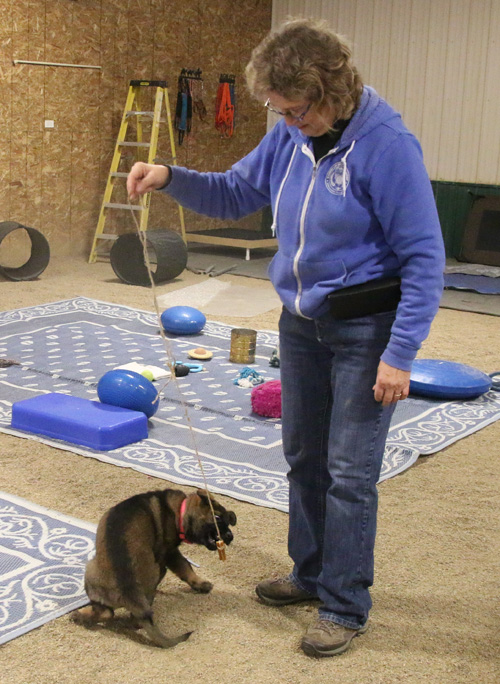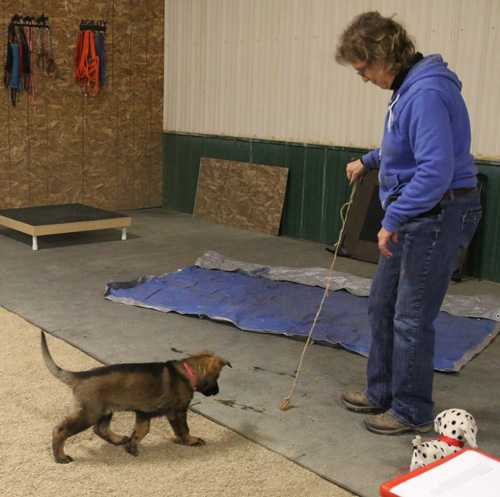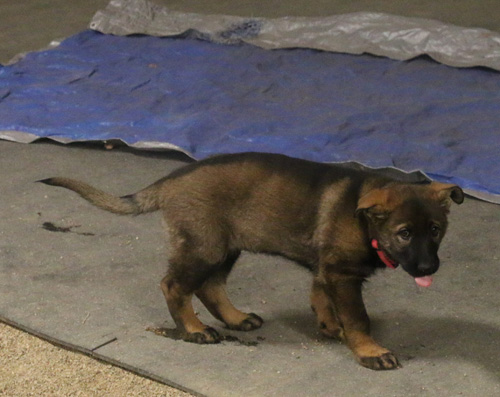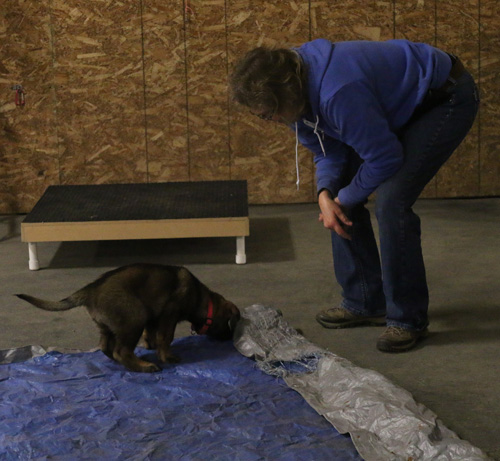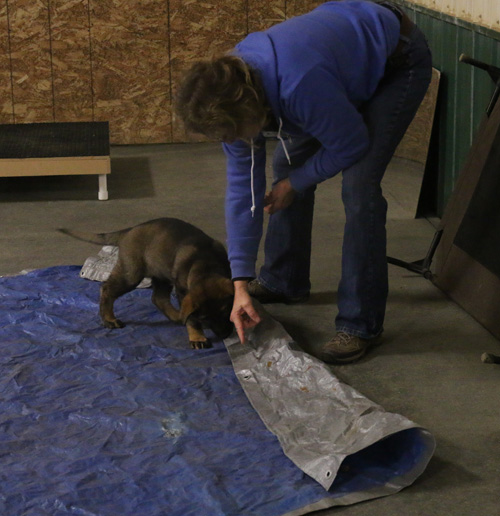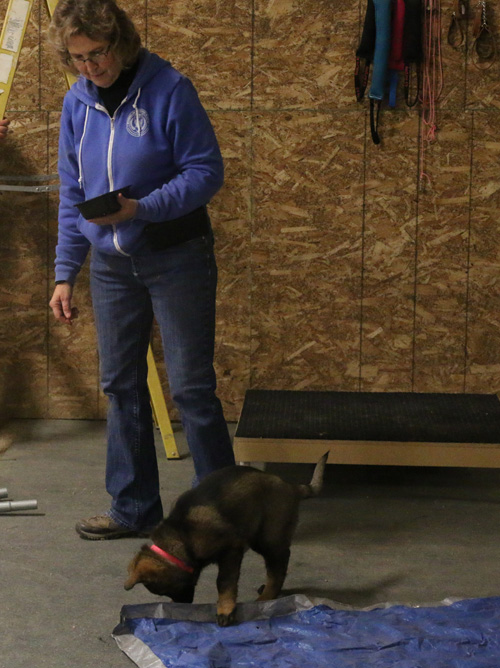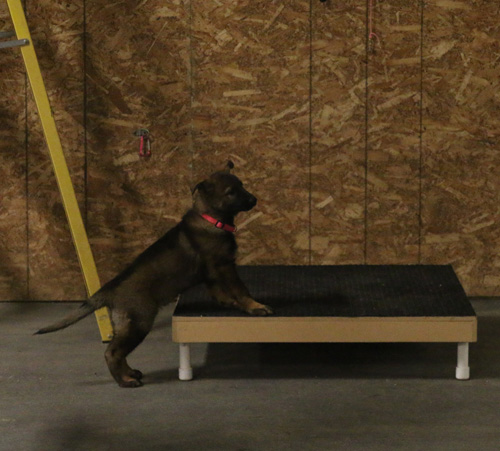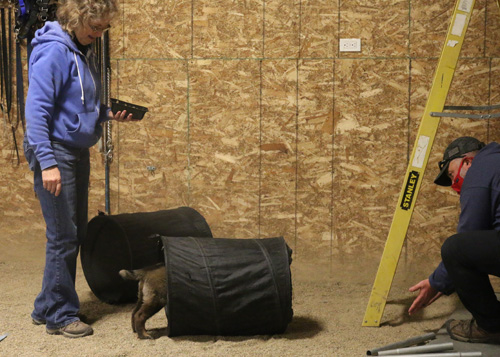Varoom!’s Police/Narcotics Dog Temperament Test
The VV Litter was tested at 54 Days.
For interest, I include Cantor’s (Varoom!’s father) temperament test results at the very end. I did not test Varoom’s mother, Hesed, when she came at 8 weeks because she was extremely stressed by the flight. She had never left the puppy pen or been alone until she was put in a crate and taken to the airport.
My good friend, Suzan Guilford, usually does the police/narcotics test. Suzan is a former K9 handler and police officer, former police chief, and has taught at the Wyoming Police Academy. She has done my temperament tests for over twenty years, except for a two-year absence while she was working in Florida. Suzan and I over the years have incorporated most of the SAR exercises into her testing so she can include them in case Bonnie can’t come do the SAR testing, which happened this time due to icy roads.
The main difference I see between the police/narcotics test and the SAR test is the attitude of the tester. In the police test, the tester is very quiet, talking little and using very little body movements. No other people are present and the environment is kept quiet. In the SAR test, the tester (often two do the test together) is somewhat more enthusiastic, uses some verbal praise and body movements to get the pup “up” and gives praise. Other people are sometimes present to watch, though they are asked to be as quiet as possible. This would fit well with the ultimate purpose of the dogs being tested for both types of training. In police work the dog must be able to dig down deep inside himself or herself to find the courage and aggression to confront a criminal and/or to search independently and at great distance from the handler. In SAR the handler is usually closer to the dog and is able to praise and encourage him, especially in extended searches. There is also generally all kinds of activity and distraction at a search scene so the dog must be able to filter out the extraneous activity and focus on her job. Both tests are fascinating to watch as is the difference in the pups’ responses in each test.
Results are listed after the description of each part of the Test. At the bottom, test results are listed for Cantor (father). We didn’t do any testing on Hesed (mother) as she was extremely stressed when I got her at 8 weeks, never having been off the place or away from littermates until she was put on the plane.
Recently Suzan adapted her test and also added an interpretation statement:
This test was designed for Police dogs and dogs of similar professions. This is a good predictor of a strong, confident dog, but also one that may be more independent and not as willing to work with humans as much as they just want to work. Having scores that are average and minimal in some categories may be just what is needed for the agility, therapy or family dog.
This test uses minimal voice, praise and encouragement.
Varoom!’s Police/Narcotics Test Results
- Social Attachment The first test involves evaluating the pup’s acceptance of the strange place and its willingness to interact with the stranger. Ideal reaction is eye contact and interest in the stranger but no sign of nervousness in the interaction (we don’t want a “Protect me!” attitude), followed by visual investigation of the surroundings and then a return of attention to the tester.
Rating: Above Average
Possible Ratings/General Description
1 – excellent: Licked face; tail up, bit at hands, face
2 – above average: Licked hands; tail up
3 – Average – good: Came readily, tail up
4 – minimal: Acknowledged tail down
5 – insufficient: Hesitant
6 – unacceptable: Did not acknowledge
- Following Observing willingness to follow handler, acceptance
Rating: Above Average
Possible Ratings/General Description
1 – excellent: Followed tail up, underfoot, bit at feet
2 – above average: Followed, tail up, underfoot
3 – Average – good: Followed, tail up
4 – minimal: Followed, tail down
5 – insufficient: Followed hesitantly, tail down
6 – unacceptable: Did not follow, went away
- Restraint/Submission The submission test, done for 30 seconds, is designed to give an idea of the pup’s tractability, trust in humans, and willingness to submit to a human’s directives. In the submission test the pup is held firmly on its back for a short period of time. The tester counts the seconds it takes for him to resist, then accept, the restraint. She should not passively accept the restraint, nor should she panic or show avoidance of eye contact. Ideal reaction is to resist, then submit and look the tester in the face. We also look for a willingness to forgive the tester.
Rating: Above Average
Possible Ratings/General Description
1 – excellent: Settled, struggled, settled with some eye contact
2 – above average: Struggled fiercely, flailed
3 – Average – good: Struggled fiercely, bit, flailed
4 – minimal: Struggled, then settled
5 – insufficient: No struggle
6 – unacceptable: No struggle, strained to avoid eye contact
- Social Dominance Stroking pup until it reacts
Rating: Minimal
Possible Ratings/General Description
1 – excellent: Cuddled up to tester, licked face
2 – above average: Jumped, pawed
3 – Average – good: Jumped, pawed, bit, growled
4 – minimal: Squirmed, licked at hands
5 – insufficient: Rolled over, licked hands
6 – unacceptable: Went away and stayed away
- Confidence/Elevation The confidence part of the test involves holding the pup out at arm’s length for several seconds. Again, the pup should accept the handler putting it in position and remain calm.
Rating: Above Average
Possible Ratings/General Description
1 – excellent: Struggled, settled, struggled, settled
2 – above average: Struggled
3 – Average – good: Struggled, tried to bite
4 – minimal: No struggle, relaxed
5 – insufficient: No struggle, body still
6 – unacceptable: No struggle, body froze
- Retrieve Ball/Toy Next, willingness to retrieve is evaluated using different balls. The tester looks for desire to chase and desire to bring back, noting independence or willingness to work with a human. Ideal reaction is to repeatedly being the toy back to the handler rather than moving off to “possess” it. The type of bite on the toys is evaluated: a full mouth bite shows more confidence and drive than a front-teeth-only bite.
Rating: Excellent
Possible Ratings/General Description
1 – excellent: Chased object, picked it up and returned with it
2 – above average: Chased object, picked it up and returned without it
3 – Average – good: Chased object, stood over it, did not return
4 – minimal: Chased object, picked it up, ran away
5 – insufficient: Started to chase, lost interest
6 – unacceptable: No chase
- (Pain) Sensitivity The loose skin over the ribs is gently pinched and the pup’s reaction is noted. Ideal reaction is to notice the pinch but be unconcerned by it. We also look for a willingness to forgive the tester.
Rating: Above Average
Possible Ratings/General Description
1 – excellent: 8 – 10 count for response
2 – above average: 6 – 8 count for response
3 – Average – good: 5 – 6 count for response
4 – minimal: 3 – 5 count for response
5 – insufficient: 2 – 3 count for response
6 – unacceptable: 1 – 2 count for response
- Prey/Perseverance Then perseverance is evaluated by seeing how enthusiastically they will pursue, grab hold, and tug on a rope or sack. They look for chasing, solidness of grip and use of body. Ideal reaction is to pursue enthusiastically, grasp with a full mouth bite, tug and do everything possible to posses the object. If a sack is used, we like to see a pup get its whole body on the sack in an effort to subdue it.
Rating: Average – Good
Possible Ratings/General Description
1 – excellent: Chased or tugged continually, full bite, used body on object
2 – above average: Chased, tugged, good bite, used feet.
3 – Average – good: Chased, tugged, bit, may release and re-bite, tail up
4 – minimal: Chased, followed object, bit, released, may tug, tail down
5 – insufficient: Chased, may bite with front-teeth bite, may lose interest
6 – unacceptable: Little or no chase or engagement
9a. Sound sensitivity-Can of Rocks A metal can filled with rocks is dropped behind them from a height of about 2 feet while they are looking away from it. Will the pup hold its ground and then go look at what dropped from nowhere? Excellent reaction is to acknowledge and turn towards the sound and then confidently go see what made the racket. The tester encourages the pup to investigate, if it doesn’t on its own. She notes how much encouragement is needed. I find most of my pups look towards the racket and keep on playing with the toy they had, rather than stopping their play to go investigate.
Rating: Above Average
Possible Ratings/General Description
1 – excellent: Heard, located sound & ran toward it
2 – above average: Heard, located sound, walked toward it
3 – Average – good: Heard, located sound and showed curiosity
4 – minimal: Heard and located sound
5 – insufficient: Cringed, backed off, tried to hide
6 – unacceptable: Ignored sound and showed no curiosity
9b. Sound sensitivity-Train A battery operated train engine that moves erratically and whistles was used. Will the pup hold its ground and then go look at what dropped from nowhere? Excellent reaction is to acknowledge and turn towards the sound and then confidently go see what made the racket. The tester encourages the pup to investigate, if it doesn’t on its own. She notes how much encouragement is needed.
Rating: Excellent
Possible Ratings/General Description
1 – excellent: Heard, located sound & ran toward it
2 – above average: Heard, located sound, walked toward it
3 – Average – good: Heard, located sound and showed curiosity
4 – minimal: Heard and located sound
5 – insufficient: Cringed, backed off, tried to hide
6 – unacceptable: Ignored sound and showed no curiosity
- Surprise/Stability The last test involves getting the pup to follow you (or a toy) towards a place with a hidden person, from behind which an umbrella is opened suddenly and then lowered to the ground, still open. The pups are evaluated on how they recover from being startled and if they’ll go investigate. Ideal reaction is for the pup to startle but hold its ground, then move right up to check out the umbrella. A super excellent reaction is to go up and bite it and/or walk all over it. The tester encourages the pup to investigate after the umbrella is on the top step, if it doesn’t on its own. She notes how much encouragement is needed.
Rating: Above Average
Possible Ratings/General Description
1 – excellent: Looked, ran to umbrella, attacked/bit
2 – above average: Looked, walked to umbrella, smelled
3 – Average – good: Looked, went to investigate
4 – minimal: Sat and looked, did not investigate
5 – insufficient: Showed little or no interest
6 – unacceptable: Ran away from umbrella
Varoom!’s Search & Rescue Test Results
Metal Object Tester tosses a set of car keys and observes to see if pup will put its mouth on it, pick it up and/or retrieve it.
Rating: N/A
Unstable Footing Since SAR dogs will search in all kinds of terrain and areas of destruction, they must be confident in insecure situations. Suzan used different FitPaws objects that made rough, unsteady surfaces and lured the pups onto and over them as they chased a tug rope.
Rating: Excellent
Hunt for Food I This test begins with a chew tied on a string and dragged to attract the pup’s interest and see how interested it is, how hard it will work to get it, and how hard it will work to keep it as the tester jerks, tugs and generally prevents the pup from easily eating it. They also hold it high to see if the pup will look up to search for it.
Rating: Above Average
Hunt for Food II Suzan hid treats around a variety of obstacles. The pups had to use their noses to find where the treats were. They were judged on how they how they used their noses, how systematic their searching was and if they would take direction from the tester.
Rating: Excellent
Tester Comments:
Pink Female: Very good & systematic. Nice nosework – more air scenting.
Summary of Test Result Ratings (Varoom! was Miss Pink)
Excellent: Retrieve Ball/Toy, Sound Sensitivity – Train, Hunt for Food II, Unstable Footing
Above average: Social Attachment, Following, Restraint/Submission, Confidence/Elevation, Pain Sensitivity, Sound Sensitivity – Can of Rocks, Surprise/Stability, Hunt for Food I
Average-good: Prey/Perseverance
Minimal: Social Dominance
Comparison of All Littermates
Social Attachment
Above average: Blue, Green, Pink
Average-good: Purple
Following
Excellent: Blue
Above average: Green, Pink
Average-good: Purple
Restraint/Submission
Excellent: Green
Above average: Pink, Purple
Insufficient: Blue
Social Dominance
Excellent: Blue, Green, Purple
Minimal: Pink
Confidence/Elevation
Above average: Pink
Minimal: Blue, Green, Purple
Retrieve ball/toy
Excellent: Blue, Green, Pink
Above Average: Blue
Average-good: Green, Purple
Sensitivity (pinch)
Excellent: Blue, Green
Above average: Pink, Purple
Prey/Perseverance
Average-good: Blue, Green, Pink, Purple
Sound Sensitivity (can)
Above average: Green, Pink, Purple
Average-good: Blue
Sound Sensitivity (train)
Excellent: Pink
Above average: Blue, Green
Average-good: Purple
Surprise (umbrella)
Average-good: Blue, Green, Pink, Purple
Retrieve Metal
Excellent: Blue
Unstable Surfaces
Excellent: Green, Pink, Purple
Above Average: Blue
Hunt for Food I
Excellent: Green
Above Average: Pink, Purple
Average-good: Blue
Hunt for Food II
Excellent: Pink, Purple
Above Average: Green
Average-good: Blue
Varoom!’s photos show these tests (in order): Unstable Footing, Retrieve, Confidence/Elevation, Sound sensitivity (train), Hunt for Food I, Hunt for Food II, her offering Manding, more Hunt for Food I, Reaction to Strange Object (battery operated stuffed dog), target table, Unstable Footing (tunnel)
Cantor’s Puppy Aptitude Test
(Varoom!’s father)
Cantor was tested in Minnesota by his breeder. The puppy aptitude test that was used on Cantor is different from ours. It was originally created by Joachim and Wendy Volhard as a way to test behavioral tendencies and predict what a puppy will be like as an adult. During the test, various exercises are done with the puppy to determine the following:
- Social Attraction: how well the puppy connects to people and whether he’s confident or dependent on others
- Following: his willingness to follow a person
- Restraint: whether the puppy is more dominant or submissive and how well he can be handled in difficult situations such as vet exams
- Social Dominance: how the puppy reacts to being dominated socially, whether he tries to dominate or if he’s independent and walks away
- Elevation: how well he accepts dominance when he’s in a position of no control
- Retrieving: how willing the puppy is to do something for you
- Touch Sensitivity: how sensitive he is to being handled, which can help determine the type of training equipment you’ll need
- Sound Sensitivity: how sensitive he is to loud noises as well as being a rudimentary test for deafness
- Sight Sensitivity: how the puppy responds to moving objects, which can reveal any tendencies to chase cars or the mailman
- Stability: how startled the puppy may be when confronted with a strange object
- Structure: This is a measure of how well-formed and proportioned the puppy is physically. A puppy with a solid build will generally be healthier than one that has issues with bone alignment.
The test done on Cantor has been revised from the original Volhard test, eliminating the structure evaluation and substituting a test of energy level. It also has only five scoring options on some tests. At the end of the test I include the Volhard’s suggestions of how to evaluate the scores.
- Social Attraction
Purpose: Degree of attraction to people
Method: Place pup in testing area 4 feet from tester, who coaxes puppy to her/him
Possible Ratings/General Description
1: Comes readily, tail up, jumps, bites at hands
2: Comes readily, tail up, paws, licks at hands
3: Comes readily, tail up
4: Comes readily; tail down
5: Comes hesitantly, tail down
6: Does not come at all
Cantor’s Score: Nothing circled
Comments: Looked at sheet (covering boundaries so watchers invisible), came tail wagging
- Following
Purpose: Degree of willingness to follow human leadership
Method: Stand up and walk away from puppy, encouraging verbally
Possible Ratings/General Description
1: Follows readily, tail up, gets underfoot, bites at feet
2: Follows readily, tail up, gets underfoot
3: Follows readily, tail up
4: Follows readily, tail down
5: Follows hesitantly, tail down
6: No follow or went away
Cantor’s Score: 3
Comments: Whined, followed tester with tail wagging
- Restraint
Purpose: Degree of dominance or submission. Response to social/physical dominance.
Method: Gently roll the pup on his back and hold it for 30 seconds. Continue holding until it no longer struggles.
Possible Ratings/General Description
1: Struggles fiercely, flails, bites
2: Struggles fiercely, flails
3: Settles, struggles, settles with eye contact
4: Slight struggle, then settles
5: No struggle, tail tucked
6: No struggle, strains to avoid eye contact
Cantor’s Score: Nothing circled
Comments: Struggled, whined whole time, eye contact at end
- Social Dominance
Purpose: Degree of acceptance of human social dominance. How “forgiving” the pup is.
Method: Pup sits facing tester at a 45 degree angle. Tester strokes pups and puts his/her face close to pup.
Possible Ratings/General Description
1: Jumps, paws, bites, growls
2: Jumps, paws, licks
3: Cuddles up to tester, tries to lick face
4: Sits quietly, accepts petting, nudges/licks hands
5: Rolls over, no eye contact
6: Goes away and stays away
Cantor’s Score: 3
Comments: Licked, wagged tail
- Elevation Dominance
Purpose: Degree of accepting dominance while in position of no control
Method: Cradle the pup under its belly, fingers interlaced, and elevate just off the ground for 30 seconds
Possible Ratings/General Description
1: Struggles fiercely, bites
2: Struggles
3: No struggle, relaxed, tail wags
4: No struggle, relaxed
5: No struggle
6: No struggle, froze, tail/rear legs tense
Cantor’s Score: Nothing circled
Comments: Whined whole time, relaxed
- Retrieving (Obedience & Aptitude)
Purpose: Degree of willingness to work with humans. High correlation between ability to retrieve and successful guide dogs, obedience dogs and field trial dogs.
Method: Attract pup’s attention with crumpled paper ball. When he is watching, toss paper 4′ away. When pup goes after it, back up two feet and encourage him to come back.
Possible Ratings/General Description
1: Chases object, picks it up and runs away
2: Chases object, stands over it, does not return
3: Chases object, picks it up and returns to tester
4: Chases object, returns without object to tester
5: Starts to chase, loses interest
6: Does not chase
Cantor’s Score: 3
Comments: Went out right away, came back to tester
- Touch Sensitivity
Purpose: Degree of sensitivity to touch
Method: Take webbing of one front foot and press between finger and thumb lightly, gradually increasing pressure on a scale from 1 – 10. Stop as soon as the puppy shows discomfort.
Possible Ratings/General Description
1: 9 – 10 counts before response
2: 7 – 8 counts before response
3: 5 – 6 counts before response
4: 3 – 4 counts before response
5: 1 – 2 counts before response
Cantor’s Score: 3
Comments: none
- Sound sensitivity
Purpose: Degree of sensitivity to sound
Method: Place pup in center of testing area and make a sharp noise a few feet away. A large metal spoon struck sharply on a metal pan twice works well.
Possible Ratings/General Description
1: Locates sound & walks toward it
2: Locates sound, barks
3: Locates sound, shows curiosity, walks toward it
4: Locates sound
5: Cringes, backs, hides
6: Ignores sound, shows no curiosity
Cantor’s Score: 4
Comments: Turned and barked
- Chase Instinct
Purpose: Degree of response to moving object: chase instinct
Method: Tie a string around a towel and drag it in front of the puppy from left to right.
Possible Ratings/General Description
1: Looks, attacks, bites
2: Looks, barks, tail up
3: Looks curiously, attempts to investigate
4: Looks, does not go forward, tail down
5: Runs away, hides
6: Ignores, shows no curiosity
Cantor’s Score: 3
Comments: Showed interest. Went away then came back.
- Stability
Purpose: Degree of intelligent response to strange object
Method: Place pup in center of testing area. Closed umbrella is held 4′ away and pointed perpendicular to the direction the pup faces. The umbrella is opened and set down so the pup can investigate.
Possible Ratings/General Description
1: Walks forward, tail up, bites
2: Walks forward, tail up, mouths
3: Walks forward, attempts to investigate
4: Goes away, tail down, hides
5: Ignores, shows no curiosity
Cantor’s Score: Nothing circled
Comments: Backed away, walked to object, stopped at 1′, came back to tester
- Energy Level
Purpose: Degree of physical energy
Method: Observe pup on the other tests and score according to the most frequent activity observed. Check with breeder for confirmation.
Possible Ratings/General Description
High: Continually runs, pounces, wiggles, paws
Medium: Mostly trots, occasionally runs, pounces, wiggles
Low: Walks slowly, sits quietly, remains in position usually
Stressed: Stands rigidly, eyes roll, tail down, ears back
Cantor’s Score: high
Overall Comments: More submissive, vocal puppy, curious, fairly confident, impulsive
“How to score the test
After you’ve administered each test and recorded the results, add up the number of one’s, two’s, three’s, etc.
Mostly One’s: This puppy has aggressive tendencies and is very dominant. He would not be a good match for families with children or elderly owners since he may be quick to bite. He would likely be a difficult dog to train and would require an experienced handler.
Mostly Two’s: This puppy is dominant. He would fit well in an adult household with an owner that can be firm and consistent in handling. Once the owner has gained his respect, he can be a very good companion. However, he may be too dominant for a household with children, or too energetic for an elderly owner.
Mostly Three’s: This puppy fits best with the average owner, accepts human leadership readily and can be good with children and elderly owners. He would likely be a good dog for obedience training, although he may be fairly active.
Mostly Four’s: This puppy is submissive and would fit with most owners, getting along well with children and elderly owners. He would train well, but may be somewhat less outgoing and energetic than a puppy that scores mostly three’s.
Mostly Five’s: This puppy is very submissive. He would not be the best choice for a first-time owner because he scares easily and needs to be taught how to be more outgoing. He would need a very regimented lifestyle to feel comfortable and open up. He’s generally safe for children, but could bite out of fear if overly stressed. Training him would take a lot of patience.
Mostly Six’s: This puppy is very independent and would be difficult to work with. He’s not very people-friendly and would require an experienced handler. He shouldn’t be matched with households with children. If you also recorded several one’s with this puppy, he may be likely to bite if stressed. This is particularly true if he scores a one in restraint.
If you find that after administering the puppy aptitude test a puppy has a few of every number, you should retest him in a few days. He may not feel well. Upon retesting, if the puppy still doesn’t show a pattern in scoring, he’s likely to have erratic behavior and may not make a good pet.”
What the scores mean for you
If you’re a first-time owner, you should look for a puppy that scores mostly three’s and four’s. One with this personality should be easy to train and family-friendly. This is particularly true if he scores a three in both social attraction and social dominance. This doesn’t mean that a puppy with other scores isn’t fit to be a pet, just that he may be better suited for owners that have more training experience. The test doesn’t pick good puppies. It only points out general personality traits a puppy will have as he grows. The puppy aptitude test should only be used as a gauge for a puppy’s temperament. It’s up to each person to make his or her own decision as to the personality they would like their puppy to have and choose based on this knowledge.”


